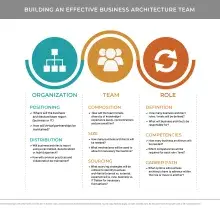Okay, thanks to Post No. 6 we know all about business architects. Now let’s talk about how we assemble them into an all-star cast to make magic.
First, who should we put on the business architecture team?
There are a lot of things to consider, but here are three biggies as you think about your own casting process.
- Levels of Knowledge and Experience – Team members should have a range of business architecture expertise and varied backgrounds. (BTW, you should have job roles and levels that reflect this.)
- Focus Areas – Team members can have various focus areas. Throwback to No. 6 where we discussed that business architects can be responsible for one, two or three of these:
- Applying business architecture to various scenarios (a.k.a. “architecting”)
- Building the business architecture knowledgebase
- Creating the business architecture practice infrastructureFor those business architects that are doing the architecting (hopefully most of your team), their focus may also vary by business scenario (e.g. strategy translation, business transformation, project portfolio management support, etc.) as well as the scope of the business they are responsible for architecting.
- Personalities – Team members should have a range of personalities and business architects are naturally drawn to different aspects of the role. For example, some like facilitation and relationship-building while others like just being brainy and building the knowledgebase.
But what if we’re just starting out?
If you are just starting a business architecture team within your organization and have a team of only one or two, you’ll need experienced people who can cover a broad range.
What else?
Two things that cannot be emphasized enough. As you build your business architecture team:
- #1 Let the value proposition of your team be your guiding light – Yep, way back to Post No. 2 again because the value you’ve said that business architecture will provide to your organization should guide who you put on the team to make that happen.
- #2 Be intentional about building a diverse team – Team diversity will make you more successful. Include people with different levels of experience, focus areas, personalities, perspectives and backgrounds.
Why is team diversity so important in this context?
A diverse business architecture team can address a broader range of scenarios, build partnerships with different types of people and solve problems more comprehensively. Business architects will also be happier and want to stay on the team because they can leverage their strengths and do what they enjoy.
Got it. Now how many people do we need on the business architecture team?
This is one of those million dollar questions, but it requires an “it depends.” A couple key drivers are the size of your organization and the amount of change initiatives (aka big stuff like enterprise transformations or acquisitions) you have going on or planned. Basically, the following formula holds true:
Business Architecture Team Size = Number of Business Architects to Cover Demand + Number of People to Support the Practice.
What exactly does that mean?
The total number of people you need on the team will come from the:
- Number of Business Architects to Cover Demand – This is the “architecting” part. You will likely allocate business architects to work with various vertical domains (like a business unit) or horizontal domains (like a set of enterprise capabilities or a cross-business unit change initiative). You may also allocate business architects to support other things like portfolio management investment decision-making.
- Number of People to Support the Practice – These people do things like build and maintain the knowledgebase and support the practice in various ways. (See No. 4 for a great reminder of all that.) Most of them will likely be business architects, but you may have people in other roles as well, such as a graphic designer who supports the architects.
And yes, the same person might do both things listed above. (Don’t count them twice.)
Will we always need the same number of business architects?
Not necessarily. And don’t worry, the number doesn’t increase indefinitely. The size of your business architecture team may fluctuate over time depending on the level of organizational change that you have going on at any point in time.
You may also want to consider clever ways to scale your team up and down. For example, you may want to borrow internal resources or leverage external resources when you need to surge in capacity to architect a lot of change.
Where do we find great business architects?
There is a high demand for a limited number of experienced business architects (relatively speaking), partially due to the fact that business architecture is still an emerging discipline so the pool is small, even globally. This means you get to be creative about where you look for business architects and many times you also get to make them.
Remember that great business architects can come from anywhere. Stay open minded and recognize that you will likely need to invest time training and aligning your team.
Here are a few options:
- Select an experienced business architect who has worked in another organization.
- Select a business person (e.g. from an area such as transformation, strategy or planning) from within or outside of your organization and train them on business architecture.
- Select an IT person (e.g. business analyst, IT Architect or another role) from within or outside of your organization and train them on both the business and business architecture.
Considering all of these options will not only increase your available pool of talent, but will also lead to a more diverse business architecture team.
Got it. Anything else?
Here’s a handy diagram to break it all down nice and simple. Basically, this is all you need to know (and define for your organization) as it pertains to the business architect role and team. Post No. 6 was on the role, No. 7 here is on the team, so guess what No. 8 will be on? Yep, the organization.
Happy team building and magic making.
More Good Stuff
The Evolution of the Business Architect (Mike Clark and Whynde Kuehn): A reflective and forward-looking white paper that focuses on how the business architect role and team have evolved and should evolve in the future. It was an honor to team up with Mike Clark on this one, who is a recognized strategic innovator, thought leader and fellow business architecture practitioner.
Business Architecture Career Center (Business Architecture Guild®): Check out the newly launched career center! (Requires Guild membership.)
37 Disney Quotes That Will Inspire You to Remarkable Success (Inc.): Just for fun. Because who doesn’t love inspiration. And Disney.

